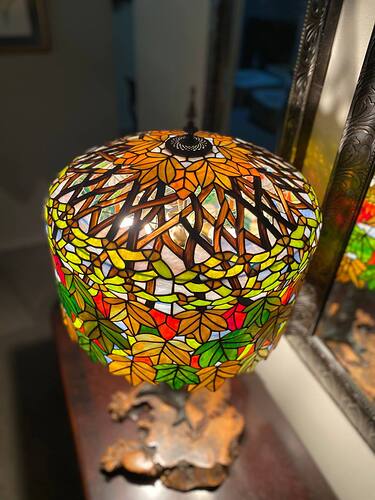Fantastic!!
The plaid-ish glass is a mystery to me. How is it done?
How is it more or less mysterious than the rest of the detail?
The glass pieces are uniform colour. The small details and black areas are painted on and heat treated (is this why it is called “stained” glass?) before the window is assembled.
The name comes from some time around the 12th century when they started using various chemicals, silver nitrate for one, to ‘stain’ the glass. This was/is applied to the glass on the back to produces variations of yellow/gold/red. The ‘paint’ on the front is a mixture of ground glass and various metal oxides along with carriers and fluxes. This is generally black or brown and can be applied in various ways depending on the desired finish. Trace lines with a fine sable, shading with a wide brushes and badgers then allowed to dry and scratched off with stiff brushes or other tools. Then fired in a kiln at different temps for different finishes.
I could go on and on, I haven’t even mentioned enamels, suffice to say Stained Glass has become the generic term for just about any coloured glass thing, but to those of us who have come up through the guilds and learnt from Masters, it is a very specific term that we understand and usually keep quiet about when others use it incorrectly.
So, yes, @Anssi is correct.
I just realized that a lot of the pieces are “painted” like the flowers. (Incorrect: see Box’s next post)
My grandma made a lamp once that looked like a tree. I didn’t remember, but while I thought every piece was one plain color, actually they weren’t.
That is a classic example of what I was talking about.
The lamp is a Tiffany style made using the copper foil technique, which is technically not stained glass. The glass pieces haven’t been decorated in any way, the mottling and colour variation is within the glass itself and is chosen by the person cutting the glass.
A true Tiffany is something else, the mechanical technique is the same but the actual work, the shape of the pieces, the complexity of the glass itself, the way the light flows is incomparable.
This thread isn’t about Stained Glass, I only popped it in as a slight aside. I’m happy to answer questions or explain things, but it’s not sketchup.
Golly, that is fantastic! And you did the rendering and lighting so well too. ![]()
So where is this located…? It’s really great work!
So, not all the beautiful stained glass windows are in Europe!
Far from it, but I have worked on many in many different parts of the world. It is quite remarkable how often very large churches can be found in regional centers and quiet rural settings. There was a lot of wealth in some parts of Australia back in the day, gold, sheep, wheat etc
So “Gold Coast” in Australia is not merely figurative…!
It’s interesting to see that in addition to “Sunshine Coast”, Australia also has towns with names like: “Wheatlands”, “Wheatvale”, “Wheatbelt” and “Sheep Hills” and “Sheep Station Creek”. I guess every nation likes to acknowledge their strengths in the names that they assign to various places. (Though Hell, MI is an exception… ![]() )
)
Thanks for sharing! Yes… Master at work. Beautiful work it is.
A, very late for me, actually early boxing day, very full of food and family and a variety of purely medicinal amber fluids, quick christmas tree structure. Embellish it as you will.
Looks like “deflated” marbles, nice colors and layout!
They are actually deflated cubes. A combination of SUbD and Clothworks.




